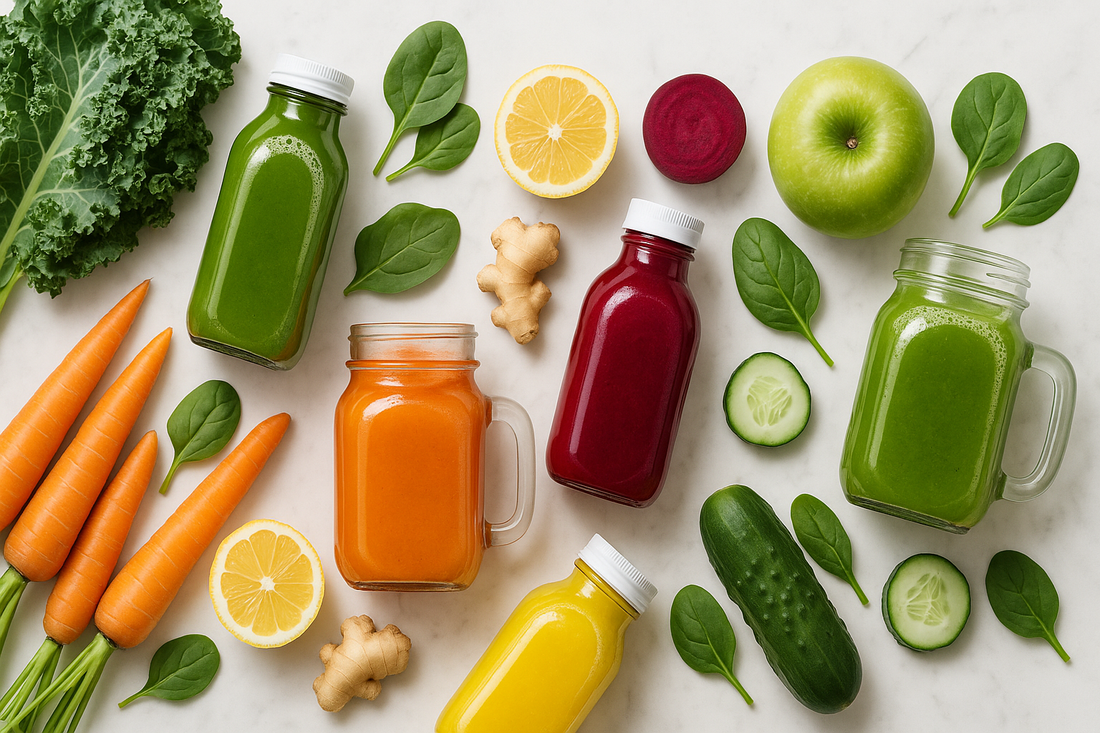
What Can You Eat on a Juice Cleanse
Share
Well, Usually Just Juice...
Embarking on a juice cleanse can feel like stepping into a world where solid foods are outlaws, and only the purest, freshest liquids reign supreme. While it might seem obvious that a juice cleanse involves, well, just juice, there's a bit more nuance to it. Let's dive into what you can (and shouldn't) eat during a juice cleanse to maximize its benefits and ensure you're not sabotaging your efforts.
🌟 Ready to start your cleanse journey? Browse our premium organic not just juice cleanses designed to reset your system and boost your energy naturally.
The Juicy Essentials: What you can have on a juice cleanse
During a juice cleanse, the primary focus is on consuming freshly pressed juices made from a variety of fruits and vegetables. These juices are designed to flood your body with vitamins, minerals, and antioxidants while giving your digestive system a break from solid foods. Here's what you should be incorporating:

1. Freshly Pressed Juices
The star of the show. When possibly opt for organic. Aim for a mix of:
- Leafy Greens: Kale, spinach, and parsley are packed with nutrients and provide a strong detoxifying punch.
- Root Vegetables: Carrots, beets, and ginger add sweetness and earthy tones, along with a slew of health benefits.
- Fruits: Apples, lemons, and berries not only add flavor but also boost vitamin content and antioxidants.
- Hydrating Veggies: Cucumbers and celery are great for hydration and add a refreshing element to your juices.
💡 Pro Tip: Enhance your cleanse results with our organic super-powders - perfect cleanse add-ons that boost nutrition and support detoxification when taken along side your cleanse!
2. Herbal Teas
Herbal teas are a great addition to your juice cleanse regimen. They can provide additional antioxidants and support detoxification. Opt for caffeine-free varieties such as:
- Peppermint Tea: Great for digestion and soothing the stomach.
- Chamomile Tea: Helps in relaxation and promotes restful sleep.
- Dandelion Tea: Supports liver detoxification.
3. Water
Staying hydrated is crucial. It may be counterintuitive as you are drinking beverages all day. But make sure to drink plenty of water to aid the cleansing process and keep your body functioning optimally.

What to Avoid During Your Juice Cleanse
While it might be tempting to sneak in a little snack here and there, sticking to the cleanse is important for the best results. Here's what you should steer clear of:
1. Solid Foods
This might seem like a no-brainer, but it's worth emphasizing. For the best benefits avoid all solid foods, including:
- Fruits and Vegetables: Even though they're healthy, the point of a juice cleanse is to consume them in liquid form.
- Nuts and Seeds: These are nutritious but should be avoided during a cleanse.
2. Caffeinated Beverages
Caffeine can interfere with the detox process and dehydrate you. But make sure you are slowly coming off coffee beforehand! Skip:
- Coffee: Even black coffee should be avoided.
- Caffeinated Teas: Opt for herbal teas instead.
3. Alcohol
Alcohol is a toxin that your body needs to process and eliminate. Consuming alcohol during a cleanse can overburden your liver and negate the benefits of the cleanse.
4. Sugary Drinks
Skip any beverages that contain added sugars, such as:
- Sodas: Full of empty calories and sugar.
- Store-Bought Juices: Unless they are 100% juice with no added sugars, avoid them.
Not all juice cleanses are created equal, be sure to look at the amount of sugar per day and if you're really interested look to see that you're getting a wide variety of fruits and vegetables.

🌿 Start Your Transformation Today
Ready to experience the benefits of a premium organic juice cleanse? Our functional cleanses are designed to deliver maximum results.
Shop All Cleanses →Navigating Temptations
Let's face it, sticking to a juice cleanse can be challenging, especially when you're surrounded by the temptations of solid food. Here are some tips to help you stay on track:
1. Preparation is Key
Prepare for your cleanse in advance to ensure you always have a healthy option on hand. This can prevent you from reaching for a quick (and likely unhealthy) snack.
2. Stay Busy
Keeping yourself occupied can help distract from hunger pangs. Engage in activities that don't revolve around food, such as:
- Going for a Walk: Fresh air and light exercise can boost your mood and energy.
- Reading a Book: Escape into a good story and keep your mind off cravings.
- Practicing Yoga or Meditation: These can help reduce stress and improve your focus.
3. Support System
Having a buddy to cleanse with or a support group can provide encouragement and accountability, making it easier to stick to your goals.
🥄 Boost Your Cleanse Results
Maximize your cleanse benefits with our premium super-powder add-ons. These organic blends provide extra nutrients, antioxidants, and detox support to enhance your cleansing experience.
Post-Cleanse Transition: What to Eat After Your Juice Cleanse
Once you've successfully completed your juice cleanse, it's crucial to transition out of the cleanse and back to solid foods gradually. Here's how you can ease back into a regular diet:
1. Start with Light Foods
Begin with easily digestible foods such as:
- Fruits and Vegetables: Fresh and steamed options are best.
- Organic Soups: Clear broths and vegetable-based soups are gentle on the stomach and perfect for easing back into solid foods.
🍲 Perfect Post-Cleanse Transition
Our organic seasonal soups are the ideal way to transition back to solid foods after your cleanse. Gentle, nutritious, and delicious!
Shop Seasonal Soups →2. Gradually Reintroduce Proteins and Grains
As your digestive system readjusts, slowly incorporate:
- Lean Proteins: Fish, chicken, and legumes.
- Whole Grains: Brown rice, quinoa, and oats.
3. Monitor Your Body's Response
Pay attention to how your body reacts to different foods. This can help you identify any sensitivities and adjust your diet accordingly.

So What Can You Actually Eat on a Juice Cleanse?
A juice cleanse can be a fantastic way to reset your system, provided you stick to the plan and avoid pitfalls. Focus on consuming a variety of nutrient-dense juices, stay hydrated, and steer clear of solid foods, caffeine, alcohol, and sugary drinks. By following these guidelines and transitioning back to solid foods mindfully, you can maximize the benefits of your juice cleanse and set the stage for healthier eating habits.
🌟 Ready to Transform Your Health?
Experience the power of functional cleansing with our premium organic juice cleanses.
Because not every juice cleanse is created equal.
If you are interested in taking it a step further and assisting your body with a functional cleanse, our specialized cleanses are designed to target specific health goals. Whether you're looking to reduce inflammation, support detoxification, or simply reset your system, we have the perfect cleanse for your needs.
🌿 Complete Your Wellness Journey
- Premium Juice Cleanses - Organic, functional, results-driven
- Super-Powder Add-ons - Boost your cleanse with targeted nutrition
- Organic Seasonal Soups - Perfect for post-cleanse transition
Embrace the journey with a sense of humor, stay committed, and enjoy the revitalizing effects that a well-executed juice cleanse can bring. Cheers to your health!
